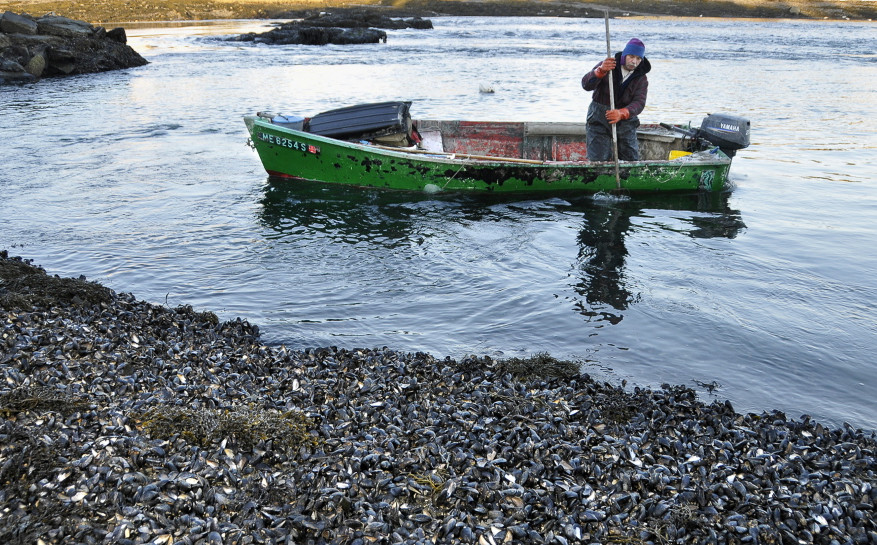I walk the shore in a place I have known longer than memory stretches. There are wide expanses of rugged beach, a tide-tumbled assortment of small rocks, sand and crushed shells. From afar, it looks much as it has for decades, a collage of tan, gray and clamshell white interspersed by hummocks of chestnut rockweed.
It is a shoreline beautiful beyond measure, but something is wrong.
Walking near the high-tide line, I find long windrows of periwinkle shells. Not the occasional sun-bleached ones amid rocks and sand, but thousands and thousands of periwinkles – their shell color still vivid, but the life in them gone. At the sight, a wave of grief – strong and unexpected – breaks over me.
The periwinkles are not the first ones to abandon this shore where the tidal life used to be breathtaking. The losses came slowly, imperceptibly at first. There were fewer sea stars and sand dollars, then none at all. New Asian markets led to overharvesting of sea urchins, and the population never rebounded.
Now the pace of loss appears to be quickening. Acres of deep blue mussel beds that drew flocks of eider ducks are gone, as are most of the birds that relied on them.
When the moon pulls the water low, the subtidal world that once was a cornucopia looks eerily void of life. Where a jungle of colors shimmered beneath the water – rose sea stars, indigo and violet mussels, lichen-green urchins – now only a drab expanse of barnacle-etched rocks remains.
I still caution my sons, reflexively, to wear swim shoes at low tide, lest they step on a sea urchin or cut their feet on mussels. They look at me blankly, and remind me that the beach bottom at low tide is no different than it is at high tide.
How much has been lost in one generation! A marine world of unimaginable fecundity is unraveling before our eyes, succumbing to ocean acidification, invasive species like green crabs and temperatures warming too fast for age-old species to adapt.
The visible changes are stark, and I cannot help but fear for the tiny phytoplankton that support the marine food web. The microscopic life of the deep sea supplies most of the oxygen in our atmosphere, literally giving us breath.
No word in the English language captures this sort of loss. We can comprehend the extinction of a particular species, or the decimation of a place (like communities lost when dams drown whole river valleys). But this is an odd hybrid, one that is becoming tragically commonplace. Some writers use the term “solastalgia” for the loss – not of place itself – but of the species and habitats that once constituted that place. Drawing from the Latin word solacium (comfort, consolation) and the Greek word algos (pain), it suggests a homesickness due – not to leaving – but to being left as other species disappear.
Place, of course, is never just a dot on a map, a GPS coordinate. It is a nesting set of natural and human communities, fitting like Russian dolls within the parameters of a particular climate, topography and seasonality. Communities evolve, and occasionally species dwindle. That is evolution and no cause for grief.
But we have tinkered irreparably with the planet’s thermostat, unleashing a tidal wave of repercussions along shores the world over. These mounds of glistening shells, so lifelike but still, spark regret tinged by guilt over our collective complacency.
My generation, and my parents’ generation, failed to grasp how closely our lives are intertwined with those of periwinkles and phytoplankton. Scientists and policy makers knew about the dynamics of global warming as far back as the 1950s and 1960s. Certainly by the 1980s, many people understood the potentially devastating implications of inaction. But the threats seemed generations off, and meanwhile there was money to be made maintaining the status quo.
If we had acted internationally to reduce greenhouse gas emissions 30, 20, even 10 years ago, would these hollow periwinkle shells still house vibrant creatures? Why, even now, can’t we bring ourselves to meaningfully address climate change?
The evidence of disruption is all about us, as grim and inescapable as the periwinkles piled on the shoreline. A new report by the International Union for the Conservation of Nature suggests that ocean warming may well be “the greatest hidden challenge of our generation.” Where does that leave the next generation?
When my sons were young, they loved to hold periwinkles in their chubby hands and hum to them – encouraging them to open. It was a small miracle for them to watch these tiny life forms emerge from inscrutable shells. These shores offered my children – and generations before them – a wealth of ordinary miracles, the gifts of a beneficent place.
Sitting now in a tide-swept graveyard of periwinkles, I wish there were something I could hum to awaken my own kind – calling us out of our shells to action.
Marina Schauffler is a freelance writer and editor who is online at naturalchoices.com.
Send questions/comments to the editors.



Success. Please wait for the page to reload. If the page does not reload within 5 seconds, please refresh the page.
Enter your email and password to access comments.
Hi, to comment on stories you must . This profile is in addition to your subscription and website login.
Already have a commenting profile? .
Invalid username/password.
Please check your email to confirm and complete your registration.
Only subscribers are eligible to post comments. Please subscribe or login first for digital access. Here’s why.
Use the form below to reset your password. When you've submitted your account email, we will send an email with a reset code.